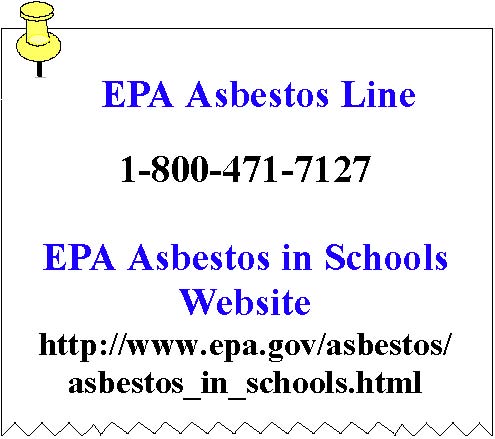FEDERAL REQUIREMENTS FOR
ASBESTOS MANAGEMENT
IN SCHOOLS
Information on Compliance with AHERA Requirements for Superintendents of Schools, Headmasters, Directors, Asbestos Inspectors & Management Planners
The Environmental Protection Agency (EPA) has developed this guidance to help Local Education Agencies (LEAs) achieve compliance with the Asbestos-Containing Materials in Schools regulation (40 CFR Part 763).
These regulations, in effect since 1986, re-quire that public and not-for-profit non-public, elementary and secondary schools be inspected to determine the presence of asbes-tos-containing building materials and that asbestos management plans be developed as a result of those inspections. State require-ments may vary. Contact your state agency for more information.

The Local Education Agency (LEA) must designate a person (designated person) to ensure that the responsibilities of the LEA, as detailed in the regulations, are properly implemented.
• The LEA must verify that this individual has received proper training. The individual is not required to be a licensed asbestos consultant. There is no specific training course for the designated person; however, the EPA has developed a “Designated Person’s Self-Study Guide” that details the required specific background knowledge the designated person must have. You can find this guide at http://www.epa.gov/asbestos/ schools.html.
• The Asbestos Management Plan (AMP) for schools must include a true and correct statement signed by the designated person certifying that the general responsibilities of the LEA have been or will be met.
• In the event that the designated person leaves his or her position, the LEA must ensure that a new individual is identified and appropriately trained to serve as the designated person. The newly identified designated person must then sign the aforementioned statement of certification. The designated person must have a basic knowledge of the health effects of asbestos, the detection, identification and assessment of asbestos-containing material, options for controlling asbestos-containing material, asbestos management programs, and relevant federal and state regulations concerning asbestos. ![]()
The LEA must retain the services of a licensed asbestos inspector or management planner to conduct a reinspection every three years subsequent to implementation of a management plan.
• Triennial reinspections must include an inspection of each area of every building that is leased, owned, or otherwise used as a school building. ![]()
At least once each school year, the LEA must provide written notification to parent, teacher, and employee
organizations regarding the availability of the Abestos Management Plan and any response actions taken
or planned.
• This notice must be dated and a copy placed in the AMP.
• The AMP must describe the steps taken to notify parents, teachers and employee organizations. Acceptable methods of notification include placing a notice in the school handbook, mailing a letter to each household, or placing an ad in a local paper. ![]()
After the AMP has been implemented, the LEA must conduct periodic surveillance in each building that it leases, owns, or otherwise uses as a school building at least once every six months.
The purpose of surveillance is to look at all known or suspect asbestos-containing building
materials (ACBM) and note any changes in the material. Periodic surveillance does not need to be conducted by a licensed consultant. It is often conducted by custodial or maintenance personnel.

All maintenance and custodial staff who may work in a building that contains asbestos-containing building
materials (ACBM) must receive at least two hours of asbestos awareness training whether or not they are
required to work with ACBM. • Maintenance and custodial staff conducting any activities that will result in the disturbance to ACBM must receive an additional fourteen hours of training.
 • The LEA must ensure that new custodial and maintenance employees are trained within sixty days after commencement of employment.
• The LEA must ensure that new custodial and maintenance employees are trained within sixty days after commencement of employment.
• The LEA must ensure that short-term workers who may come in contact with asbestos (e.g. utility repair workers) are informed of the location of ACBM. 
![]()
The LEA must maintain records required by the regulations to be included in the Asbestos Man-
agement Plan. This includes: • a copy of prior inspection and/or reinspection reports;
• documentation related to the training provided to custodial and maintenance employees;
• periodic surveillance forms;
• dated statements regarding operations and maintenance activities;
• a copy of the annual notice of the management plan availability;
• a copy of all reports on response actions taken; and
• a copy of the updated management plan in each school. 


![]()

![]()
EPA is committed to providing assistance to LEAs to ensure compliance with regulatory requirements. While it is the goal of EPA to provide LEAs with assistance in achieving regulatory compliance voluntarily, LEAs that fail to comply with existing regulatory requirements will be subject to enforcement action. Contact your Regional Asbestos Coordinator for more information.
